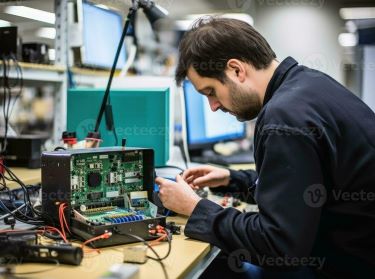
Electrical and electronics engineering technicians help engineers design and develop computers, communications equipment, medical monitoring devices, navigational equipment, and other electrical and electronic equipment. They often work in product evaluation and testing, and use measuring and diagnostic devices to adjust, test, and repair equipment. They are also involved in the manufacture and deployment of equipment for automation.
Electrical engineering technicians install and maintain electrical control systems and equipment, and modify electrical prototypes, parts, and assemblies to correct problems. When testing systems, they set up equipment and evaluate the performance of developmental parts, assemblies, or systems under simulated conditions. They then analyze test information to resolve design-related problems.
Electronics engineering technicians, by comparison, design basic circuitry and draft sketches to clarify details of design documentation, under the direction of a licensed engineer. They may also be called on to assemble, test, and maintain circuitry components according to engineering manuals. In order to accomplish this, they may fabricate custom parts, such as coils and terminal boards, by using bench lathes, drills, or other computer-controlled machine tools. They also calibrate and perform preventive maintenance on equipment and systems.
Programs for electronics engineering technicians usually lead to an associate's degree in electrical or electronics engineering technology. In the digital electronics course, students delve into the realm of digital logic and circuits. They learn about logic gates and how they form the building blocks of digital systems. Through Boolean algebra and binary arithmetic, students understand how to design and analyze combinational and sequential logic circuits. Topics include flip-flops, registers, counters, and practical digital circuit design techniques.
Troubleshooting and Repair Techniques equips students with the skills necessary to diagnose and repair electronic systems and equipment. They learn systematic approaches to troubleshooting, including fault identification, isolation, and resolution. Students become proficient in using test equipment such as multimeters, oscilloscopes, and signal generators to diagnose circuit faults. They also learn repair techniques for replacing components, soldering connections, and conducting functional tests to verify repairs.
The electronics project lab provides students with an opportunity to apply their knowledge and skills to real-world projects. Working individually or in teams, students design, build, test, and troubleshoot electronic circuits and systems under the guidance of instructors. Projects may involve designing a digital clock, building a temperature-controlled system, or developing a small-scale automation project.
Electrical Safety and Codes focuses on ensuring safe practices in the installation, operation, and maintenance of electronic systems. Students learn about electrical hazards, safety standards, and regulations governing electrical work, including the National Electrical Code (NEC). Topics include electrical shock, arc flash, protective measures, grounding and bonding, and personal protective equipment.
ETA International offers certifications in several fields, including basic electronics, biomedical electronics, and renewable energy. The International Society of Automation offers certification as a Control Systems Technician. To gain such certification, technicians must demonstrate skills in pneumatic, mechanical, and electronic instrumentation. In addition, they must demonstrate an understanding of process control loops and process control systems.
The Technology Accreditation Commission of accredits programs, as does the National Institute for Certification in Engineering Technologies (NICET). This certification would benefit those technicians working in the electric power generation, transmission, and distribution industry.
Diagnostics and repair of a HP laptop with several electronics repair issues.
This video teaches how to read a schematic diagram, and build a circuit using standard electronic components.
Manufactuing processes of Integrated Circuits, CPUs, GPUs, Systems on a Chip, and Microcontroller Chips.
A printed circuit board (PCB), also called printed wiring board (PWB), is a medium used to connect or "wire" components to one another in a circuit.
The electronics technician program trains candidates to repair and maintain communications hardware, computers, and other electronic devices. Courses focus on evaluation and testing, using diagnostic equipment to calibrate, and repair electrical instrumentation. Students may draw diagrams and write specifications for design improvement.
Ask yourself if you can see yourself as a professional electronics technician, having daily contact with the public. In today's competitive environment, you are well-advised to attend an electronics training program, as well as perform an apprenticeship. While classes and internships will prepare you well, certain innate qualities that you bring to bear will help you succeed.
Attending college offers benefits beyond academic learning. Students are exposed to diverse perspectives that challenge their thinking. This fosters problem-solving and communication. College is also about social skills. Whether through student organizations or sports teams, students develop leadership skills and build lasting friendships.
This website is not affiliated with any educational institution, and all trademarks are the exclusive property of the respective owners. All copyrighted works on this website are offered for educational purposes only, governed by the four-factor rule, section 107 of the Copyright Act. CampusInspector.com is the work of a group of students in Bangkok, using data from the US Department of Education, Postsecondary Education Data System (IPEDS). If any information is incorrect, please contact us with updates.